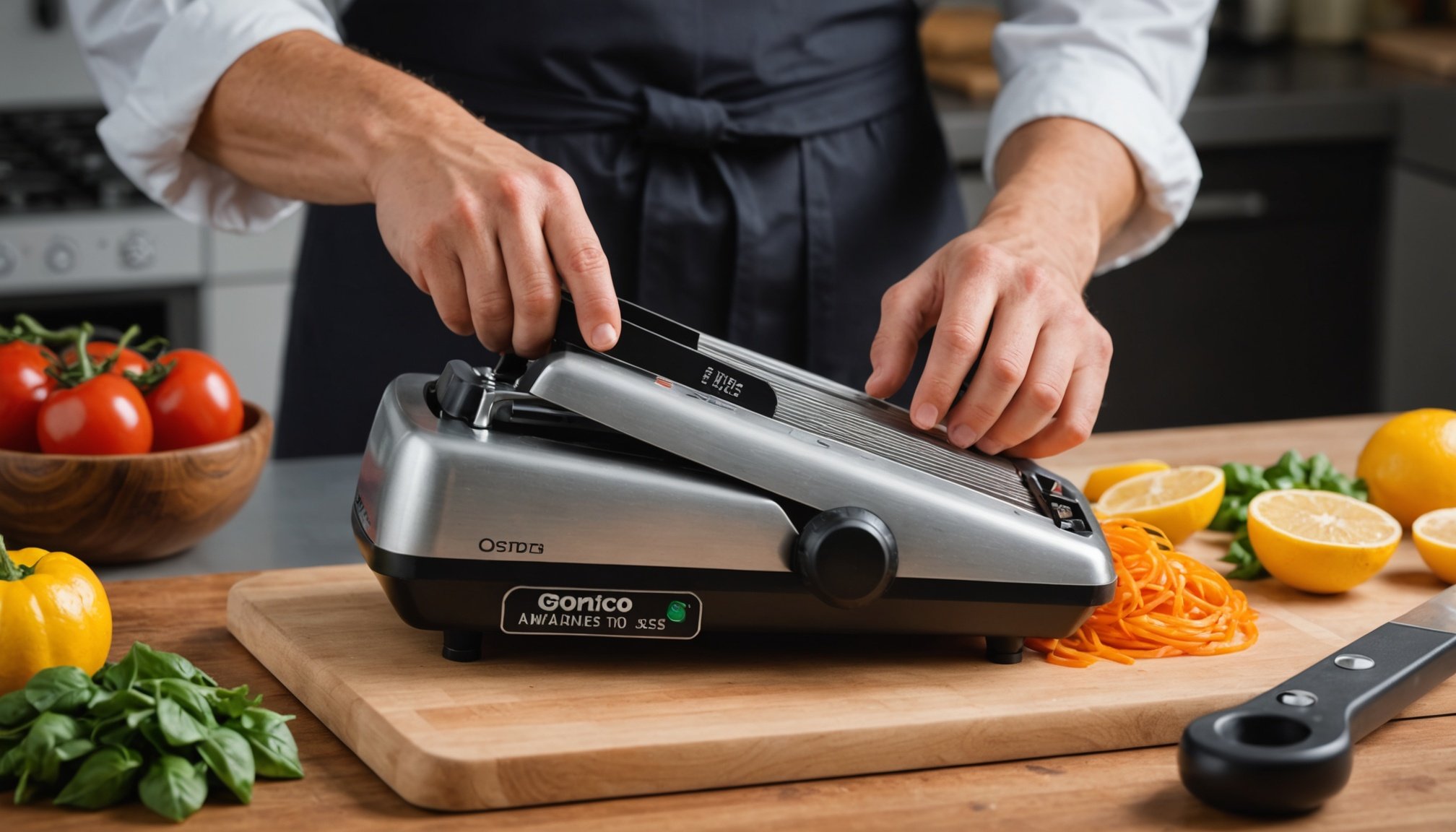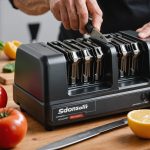Mastering Mandoline Slicer Safety: Top Techniques for Effortless and Secure Slicing!
Using a mandoline slicer can be a game-changer in the kitchen, allowing you to achieve uniform slices of vegetables, fruits, and even meats with ease. However, the sharp blades and precise mechanics of these tools also pose a significant risk if not used correctly. Here’s a comprehensive guide to help you master the art of safe and efficient slicing with your mandoline slicer.
Understanding Your Mandoline Slicer
Before diving into the techniques, it's crucial to understand the components and features of your mandoline slicer. Here are some key elements to familiarize yourself with:
In the same genre : Mastering Kitchen Hygiene: The Ultimate Guide to Safely Sanitize Your Wooden Cooking Utensils
Components of a Mandoline Slicer
- Blades: Typically made of stainless steel, these are the heart of your mandoline slicer. They come in various sizes and types, such as julienne, thin slice, and thick slice blades.
- Adjustable Settings: Many mandoline slicers allow you to adjust the thickness of your slices. This feature is usually controlled by a dial or lever.
- Hand Guard: A safety feature that protects your hand from the blade. It is essential to use this guard when slicing to prevent accidents.
- Non-Slip Base: Ensures the mandoline slicer stays stable on your cutting board, reducing the risk of it slipping and causing injury.
Safety First: Essential Tips for Using a Mandoline Slicer
Safety should always be your top priority when using a mandoline slicer. Here are some essential tips to keep in mind:
Use the Hand Guard
The hand guard is a critical safety feature that prevents your fingers from coming into contact with the blade. Always use it when slicing, especially when you're new to using a mandoline slicer.
This might interest you : Essential Factors to Consider When Selecting a Heat-Resistant Soup Ladle That Stands the Test of Time
Choose the Right Blade
Different blades are designed for different tasks. For example, a julienne blade is perfect for slicing vegetables into thin strips, while a thick slice blade is better for slicing potatoes. Make sure you select the right blade for your task to avoid accidents and ensure the best results.
Positioning the Mandoline Slicer
Place your mandoline slicer on a stable, non-slip surface. A cutting board with good grips can help prevent the slicer from moving around while you're using it.
Slicing Technique
- Hold the Vegetable Correctly: Hold the vegetable firmly against the hand guard, ensuring that your fingers are completely protected.
- Apply Gentle Pressure: Apply gentle, consistent pressure as you push the vegetable through the blade. Avoid applying too much pressure, which can cause the vegetable to slip and potentially harm you.
- Slice Away from Your Body: Always slice in a direction away from your body to prevent any accidental cuts if the vegetable slips.
Best Practices for Efficient Slicing
Efficient slicing is not just about safety; it's also about getting the job done quickly and effectively. Here are some best practices to help you slice like a pro:
Prepare Your Ingredients
Before you start slicing, make sure your ingredients are clean and dry. This helps the slicing process go smoother and reduces the risk of the vegetable slipping off the blade.
Use the Right Angle
Hold the mandoline slicer at a slight angle to ensure that the blade cuts through the vegetable smoothly. This angle also helps in achieving uniform slices.
Maintain Your Mandoline Slicer
Regular maintenance is key to keeping your mandoline slicer in good condition. Clean the blades and other parts after each use, and store the blades safely to prevent accidents.
Common Mistakes to Avoid
Even with the best practices in place, there are some common mistakes that can lead to inefficiency or safety issues. Here are a few to watch out for:
Not Using the Hand Guard
This is one of the most critical mistakes you can make. Always use the hand guard to protect your fingers from the sharp blade.
Applying Too Much Pressure
Applying too much pressure can cause the vegetable to slip and potentially harm you. Use gentle, consistent pressure instead.
Slicing Tough or Overly Tender Foods
Avoid slicing foods that are excessively tough or overly tender. Tough foods can cause the blade to break, while tender foods may not slice evenly.
Comparing Different Mandoline Slicers
When choosing a mandoline slicer, there are several factors to consider. Here’s a comparison of some key features in different models:
| Feature | Enleber Mandoline Slicer | DASH Safe Slice Mandoline Slicer | OXO Good Grips Mandoline Slicer |
|---|---|---|---|
| Material | ABS plastic, stainless steel blades | BPA-free plastic, stainless steel blades | BPA-free plastic, stainless steel blades |
| Adjustable Settings | Yes, 6 different blade sizes | Yes, adjustable thickness settings | Yes, adjustable thickness settings |
| Hand Guard | Yes, with ultra-sharp hidden steel blades | Yes, with safety guard | Yes, with safety guard |
| Non-Slip Base | Yes | Yes | Yes |
| Ease of Cleaning | Easy to clean with small brush and food catch container | Easy to clean with dishwasher-safe parts | Easy to clean with dishwasher-safe parts |
| Additional Features | Foldable design, multiple blade sizes | Compact design, easy storage | Ergonomic handle, comfortable grip |
Practical Insights and Actionable Advice
Here are some practical tips and advice from experienced chefs and home cooks:
Chef Meredith's Tip
"When using a mandoline slicer, it's crucial to maintain a steady hand and apply consistent pressure. This ensures you get uniform slices every time," says Chef Meredith from Sur La Table.
Customer Feedback
"Using the hand guard has been a game-changer for me. It's so much safer and easier to slice vegetables now," says a satisfied customer of the Enleber Mandoline Slicer.
Mastering the use of a mandoline slicer is a skill that can elevate your cooking to the next level. By understanding the components of your slicer, following safety tips, and adopting best practices, you can ensure that your slicing experience is both efficient and safe.
Key Takeaways
- Always use the hand guard to protect your fingers.
- Choose the right blade for the task.
- Maintain your mandoline slicer regularly.
- Apply gentle, consistent pressure when slicing.
- Avoid slicing tough or overly tender foods.
With these tips and a bit of practice, you'll be slicing like a pro in no time, making meal prep and food preparation a breeze in your kitchen. Happy slicing











